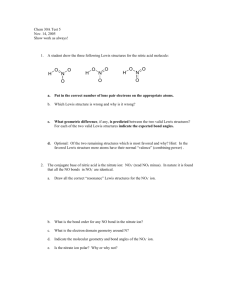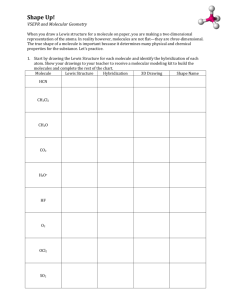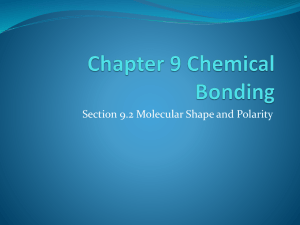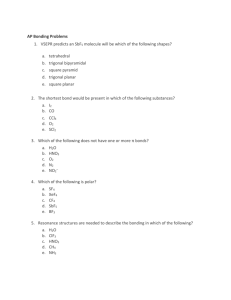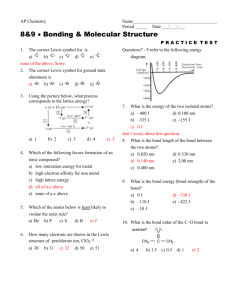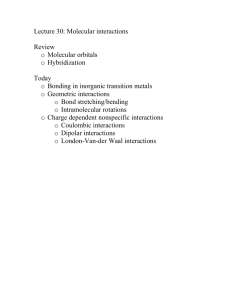117 Practice Problems – Chapter 13
advertisement
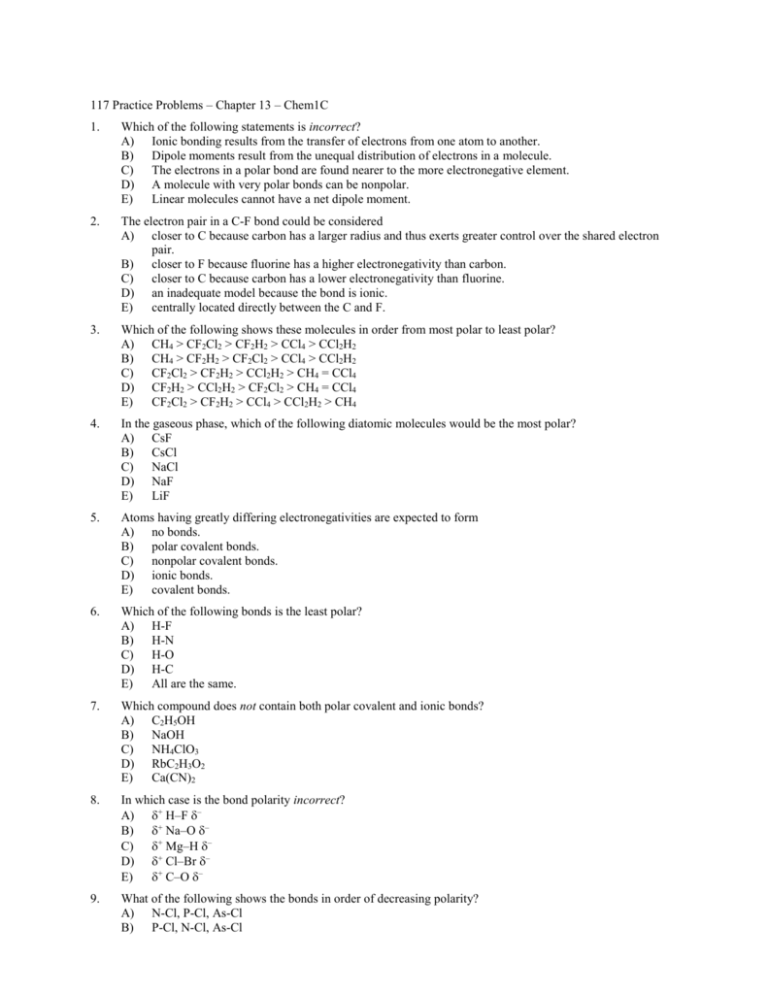
117 Practice Problems – Chapter 13 – Chem1C 1. Which of the following statements is incorrect? A) Ionic bonding results from the transfer of electrons from one atom to another. B) Dipole moments result from the unequal distribution of electrons in a molecule. C) The electrons in a polar bond are found nearer to the more electronegative element. D) A molecule with very polar bonds can be nonpolar. E) Linear molecules cannot have a net dipole moment. 2. The electron pair in a C-F bond could be considered A) closer to C because carbon has a larger radius and thus exerts greater control over the shared electron pair. B) closer to F because fluorine has a higher electronegativity than carbon. C) closer to C because carbon has a lower electronegativity than fluorine. D) an inadequate model because the bond is ionic. E) centrally located directly between the C and F. 3. Which of the following shows these molecules in order from most polar to least polar? A) CH4 > CF2Cl2 > CF2H2 > CCl4 > CCl2H2 B) CH4 > CF2H2 > CF2Cl2 > CCl4 > CCl2H2 C) CF2Cl2 > CF2H2 > CCl2H2 > CH4 = CCl4 D) CF2H2 > CCl2H2 > CF2Cl2 > CH4 = CCl4 E) CF2Cl2 > CF2H2 > CCl4 > CCl2H2 > CH4 4. In the gaseous phase, which of the following diatomic molecules would be the most polar? A) CsF B) CsCl C) NaCl D) NaF E) LiF 5. Atoms having greatly differing electronegativities are expected to form A) no bonds. B) polar covalent bonds. C) nonpolar covalent bonds. D) ionic bonds. E) covalent bonds. 6. Which of the following bonds is the least polar? A) H-F B) H-N C) H-O D) H-C E) All are the same. 7. Which compound does not contain both polar covalent and ionic bonds? A) C2H5OH B) NaOH C) NH4ClO3 D) RbC2H3O2 E) Ca(CN)2 8. In which case is the bond polarity incorrect? A) + H–F – B) + Na–O – C) + Mg–H – D) + Cl–Br – E) + C–O – 9. What of the following shows the bonds in order of decreasing polarity? A) N-Cl, P-Cl, As-Cl B) P-Cl, N-Cl, As-Cl C) D) E) As-Cl, N-Cl, P-Cl P-Cl, As-Cl, N-Cl As-Cl, P-Cl, N-Cl 10. Which of the following is nonpolar? A) Cl2O B) CS2 C) SF4 D) NCl3 E) IF3 11. Which of the following is polar? A) SiF4 B) XeF2 C) BCl3 D) NBr3 E) SBr6 12. Which statement is correct? A) H2O is linear. B) The molecule ClO2 cannot be accurately described by a Lewis structure consistent with the octet rule. C) The diatomic molecule Cl2 is an example of a polar molecule. D) The bonds in LiF have a more covalent character than those in F2. E) none of these 13. Which of the following molecules does not have a dipole moment? A) H2S B) H2O C) H2Xe D) All of these have a dipole moment. E) None of these has a dipole moment. 14. Which of the following molecules has a nonzero dipole moment? A) CCl4 B) SiF4 C) CS2 D) SO3 E) PBr3 15. Which of the following molecules has a dipole moment? A) CF4 B) SF4 C) XeF4 D) All of these have a dipole moment. E) None of these has a dipole moment. 16. Which of the following molecules has a dipole moment? A) SCl6 B) BH3 C) CO2 D) OF2 E) None of these has a dipole moment. 17. Which of the following molecules has a dipole moment? A) BCl3 B) SiCl4 C) PCl3 D) Cl2 E) none of these 18. Which of the following molecules has a zero dipole moment? A) XeF2 B) NCl3 C) H2O D) SCl4 E) ICl3 Use the following to answer question 19: Consider the following molecules. I. BF3 II. CHBr3 III. Br2 IV. XeCl2 V. Select the molecule(s) that fit the given statement. CO VI. SF4 19. These molecules have a zero net dipole moment. A) III, V B) I, III, IV C) III, IV, V D) I, III, IV, VI E) none of them 20. Which of the following has a zero dipole moment? A) NH3 B) NO2 C) PF5 D) SO2 E) HCN 21. Choose the statement that best describes the PbCl4 molecule in the gas phase. A) The bond angles are all about 109°. B) The molecule is polar. C) The molecule has a dipole moment. D) The bonds are nonpolar. E) The molecule is polar with bond angles of about 109°. 22. As the number of bonds between two carbon atoms increases, which one of the following decreases? A) the number of electrons between the carbon atoms B) the bond energy C) the bond length D) all of these E) none of these 23. Choose the molecule with the strongest bond. A) F2 B) Cl2 C) Br2 D) I2 24. Choose the molecule with the strongest bond. A) HF B) HCl C) HBr D) HI 25. Choose the molecule with the strongest bond. A) CH4 B) H2O C) NH3 D) HF 26. Which of the following molecules exhibits the greatest bond energy? A) F2 B) Cl2 C) Br2 D) I2 E) all the same 27. Which of the following molecules and ions has a lone pair of electrons on the central atom? A) CH3+ B) XeO4 C) BeCl2 D) CH3– E) PCl5 28. This molecule shows the smallest number of lone pairs in its Lewis structure. A) CH3CHO B) CO2 C) D) E) CH3Cl C2H6 none of these 29. Which of the following molecules contains a double bond? A) CO2 B) NH3 C) H2O D) all E) none 30. Which of the following compounds contains only one unshared pair of valence electrons? A) NH3 B) H2O C) CH4 D) NaCl E) BeF3 31. What does X represent in the Lewis structure X=X? A) O B) C C) N D) F E) B 32. In the Lewis structure for elemental nitrogen, there is(are) A) a single bond between the nitrogens. B) a double bond between the nitrogens. C) a triple bond between the nitrogens. D) three unpaired electrons. E) none of these Use the following to answer questions 33-34: Consider the compound, whose skeleton is H H H H H C1 C2 C3 C4 O H 33. How many electrons must be shown in the Lewis structure of this molecule? A) 12 B) 18 C) 24 D) 28 E) 32 34. How many nonbonding electrons appear in the Lewis structure of this molecule? A) 2 B) 4 C) 6 D) 8 E) 10 35. As indicated by Lewis structures, which of the following would probably not exist as a stable molecule? A) CH3OH B) CH2O C) CH3O D) C2H2 E) C3H4 36. For which of the following can we not draw a stable Lewis structure? A) PCl5 B) OCl6 C) SCl6 D) All of these have stable Lewis structures. E) None of these has a stable Lewis structure. 37. Select the best Lewis structure for acetone, CH3COCH3. H H A) H B) C) D) C H C O C H H H O H H C C C H H H H H C C O H C H H H H H H C C O C H H H H H H H C C C O E) H H Use the following to answer question 38: Draw the Lewis structures of the molecules below, and use them to answer the following questions. I. BH3 II. NO2 III. SF6 IV. O3 V. PCl5 38. Which of the molecules obeys the octet rule? A) I B) II C) III D) IV E) V Use the following to answer questions 39-40: Given the following Lewis structure: H H H H2C C C C CH3 1 2 3 4 5 39. How many unshared pairs of electrons are present in this molecule? A) 0 B) 1 C) 2 D) 3 E) 4 40. How many electrons are shared between carbons 1 and 2? A) 0 B) 2 C) 4 D) 6 E) 8 41. The Lewis structure for H3BO3 is A) H O B O H O H O H O H O H O H B) H O B O H C) H O B O H D) H O B O H E) H O B O H 42. When molten sulfur reacts with chlorine gas, a vile-smelling orange liquid forms that is found to have the empirical formula SCl. Which of the following could be the correct Lewis structure for this compound? S Cl S Cl S Cl D) Cl S S Cl E) Cl S S Cl A) B) C) Cl S 43. Complete the Lewis structure for the molecule CH3 O CH3 CH C C N This molecule has __________ single bonds and __________ multiple bonds. A) B) C) D) E) 4, 2 6, 3 11, 5 11, 2 13, 0 44. As indicated by Lewis structures, which of the following species could probably not exist as a stable molecule? A) NH3 B) N2H2 C) N2H4 D) N2H6 E) N2O4 45. How many electrons are in the Lewis structure for SO2? A) 16 B) 30 C) 18 D) 20 E) 32 46. How many of the following molecules and ions contain double or triple bonds? N2 H2CO C2H4 C2H6 SCN– A) B) C) D) E) 1 2 3 4 5 47. In the Lewis structure for I3–, there are _________ electrons around the central iodine atom. A) 4 B) 8 C) 10 D) 12 E) none of these 48. Which species has an unpaired electron? A) N2 B) CO C) NO D) OH– E) none of these 49. How many of the following exhibit resonance? O3 OCl2 NF3 CCl4 A) 0 B) 1 C) 2 D) 3 E) 4 50. For which compound is resonance required to describe the structure adequately? A) PCl3 B) CO32– C) HCN D) NH4+ E) none of these 51. How many resonance structures does the molecule SO2 have? A) 0 B) 1 C) 2 D) 3 E) 4 52. Which molecule or ion violates the octet rule? A) H2O B) NO3– C) PF3 D) I3– E) none of these 53. Which of the following is not a valid resonance structure for N3–? N N N N N N N N N N N N - A) - B) - C) D) E) 54. All are valid. How many acceptable and equivalent resonance structures can be drawn for NO 3–? A) 0 B) 1 C) 2 D) 3 E) 4 Use the following to answer question 55: Draw the Lewis structures of the molecules below, and use them to answer the following questions. I. BH3 II. NO2 III. SF6 IV. O3 V. PCl5 55. Which of these molecules show resonance? A) I, II B) II, IV C) II, V D) III, IV E) III, V 56. Which of the following has an incomplete octet in its Lewis structure? A) SO2 B) ICl C) SF2 D) F2 E) NO 57. In the Lewis structure for SF6, the central sulfur atom shares __________ electrons. A) 4 B) 8 C) 10 D) 12 E) none of the above, because SF6 is an ionic compound 58. Choose the electron dot formula that most accurately describes the bonding in CS 2. (Hint: Consider formal charges.) C) S C S C S S S C S D) S C S E) S C S A) B) Use the following to answer question 59: Consider the following molecules. I. BF3 II. CHBr3 (C is the central atom.) III. Br2 IV. XeCl2 V. CO VI. SF4 Select the molecule(s) that fit the given statement. 59. These molecules violate the octet rule. A) I, II, IV B) I, III, IV, VI C) III, V, VI D) I, IV, VI E) I, II, IV, VI 60. Which molecule or ion violates the octet rule? A) CH4 B) I3– C) NO3– D) CO2 E) SO3 61. The molecule XCl5– has a square pyramidal shape. Which of the following atoms could be X? A) O B) P C) Xe D) S E) At least two of these atoms could be X. 62. How many Lewis structures does CO32– have? A) 1 B) 2 C) 3 D) 4 E) 5 63. Which of the following has the Lewis structure most like that of CO 32–? A) CO2 B) SO32– C) NO3– D) O3 E) NO2 64. Which of the following Lewis structures best describes BF3? A) F F B F B) F F B F C) F F B F D) F F B F E) F F B F 65. The Cl–Kr–Cl bond angle in KrCl4 is closest to A) 90°. B) 109°. C) 120°. D) 150°. E) 360° 66. Of the following, which molecule has the largest bond angle? A) SO3 B) SF2 C) HCN D) H2S E) PF3 67. Which of the following statements about the species N2, CO, CN– and NO+ is false? A) All are isoelectronic. B) Each contains a triple bond. C) All are linear. D) The bond in each species is polar. 68. This molecule contains a carbon atom with trigonal planar geometry. A) CH3CHO B) CO2 C) CH3Cl D) C2H6 E) none of these Use the following to answer question 69: Draw the Lewis structures of the molecules below, and use them to answer the following questions. I. BH3 II. NO2 III. SF6 IV. O3 V. PCl5 69. How many of the molecules have no dipole moment? A) 1 B) 2 C) 3 D) 4 E) They are all polar. 70. Consider the compound, whose skeleton is H H H H H C1 C2 C3 C4 O H Which carbon in this molecule has tetrahedral bonding? A) 1 B) 2 C) 3 D) 4 E) All have tetrahedral bonding. 71. Select the correct molecular structure for SF4. A) linear B) bent C) square pyramid D) tetrahedral E) none of these 72. Select the correct molecular structure for I3–. A) linear B) bent C) trigonal pyramidal D) tetrahedral E) none of these 73. Select the correct molecular structure for NH3. A) linear B) bent C) trigonal pyramidal D) tetrahedral E) none of these 74. Select the correct molecular structure for XeF4. A) linear B) bent C) square pyramid D) tetrahedral E) none of these 75. Select the correct molecular structure for SO2. A) linear B) bent C) trigonal pyramidal D) tetrahedral E) none of these 76. How many of the following molecules and ions are linear? NCl3 NH4+ SCNCO2 NO2A) 0 B) 1 C) 2 D) 3 E) 4 77. The bond angles about the carbon atom in the formaldehyde molecule, H 2C = O, are about A) 120°. B) 60°. C) 109°. D) 180°. E) 90°. 78. What type of structure does the XeOF2 molecule have? A) trigonal pyramidal B) tetrahedral C) T-shaped D) trigonal planar E) octahedral 79. Which ion is planar? A) PF4+ B) CO32– C) SO32– D) ClO4– E) SCl5- 80. Select the correct molecular structure for NO3–. A) trigonal pyramidal B) tetrahedral C) square planar D) octahedral E) none of these 81. Select the correct molecular structure for IF6+. A) square pyramid B) tetrahedral C) square planar D) octahedral E) none of these 82. Select the correct molecular structure for SF5+. A) square pyramid B) tetrahedral C) square planar D) octahedral E) none of these 83. Select the correct molecular structure for IF5. A) square pyramid B) tetrahedral C) square planar D) octahedral E) none of these 84. Select the correct molecular structure for XeCl4. A) square pyramid B) tetrahedral C) square planar D) octahedral E) none of these 85. Select the correct molecular structure for PF3. A) trigonal pyramidal B) tetrahedral C) square planar D) octahedral E) none of these 86. Select the correct molecular structure for PO43–. A) trigonal pyramidal B) tetrahedral C) square planar D) octahedral E) none of these 87. Select the correct molecular structure for PO33–. A) trigonal pyramidal B) tetrahedral C) square planar D) octahedral E) none of these 88. What is the shape of the ICl5 molecule? A) square pyramid B) trigonal bi-pyramid C) octahedral D) see-saw E) none of these 89. How many of the following molecules have all of their atoms in the same plane? H2C = CH2 F2O H2CO NH3 CO2 BeCl2 H2O2 1. 2. 3. 4. 5. 6. 7. 8. 9. 10. A) B) C) D) E) 3 4 5 6 7 E B D A D D A D E B 11. 12. 13. 14. 15. 16. 17. 18. 19. 20. D B C E B D C A B C 21. 22. 23. 24. 25. 26. 27. 28. 29. 30. A C A A D A D D A A 31. 32. 33. 34. 35. 36. 37. 38. 39. 40. A C D B C B B D A C 41. 42. 43. 44. 45. 46. 47. 48. 49. 50. C E D D C D C C B B 51. 52. 53. 54. 55. 56. 57. 58. 59. 60. C D A D B E D A D B 61. 62. 63. 64. 65. 66. 67. 68. 69. 70. D C C A A C D A C A 71. 72. 73. 74. 75. 76. 77. 78. 79. 80. E A C E B C A C B E 81. 82. 83. 84. 85. 86. 87. 88. 89. D E A C A B A A C


